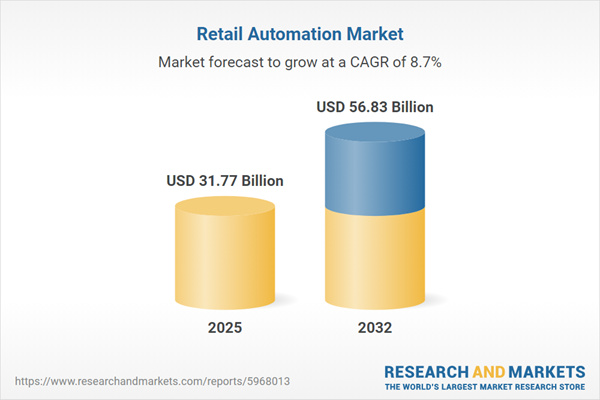Speak directly to the analyst to clarify any post sales queries you may have.
The retail automation market is reshaping how industry leaders approach transformation, enabling the seamless integration of advanced digital technologies that boost efficiency, agility, and customer engagement, both online and at physical points of sale. In a fast-changing economic and regulatory landscape, automated systems help executives future-proof retail operations and maintain competitive standing.
Market Snapshot: Retail Automation Market Size, Growth, and Outlook
The retail automation market is valued at USD 29.21 billion in 2024, with anticipated growth to USD 31.77 billion by 2025 and USD 56.83 billion by 2032, resulting in a compound annual growth rate (CAGR) of 8.67%. Core industry drivers include increased investments in robotics, advanced analytics, and end-to-end automation solutions. These technological enhancements support modernization of digital infrastructure, allowing retailers to adapt supply chains and take advantage of evolving commerce channels. Market advancement in this sector is closely tied to organizational goals in operational agility, scalability, and sustained competitiveness.
Scope & Segmentation of the Retail Automation Market
- Software: Analytical tools, inventory controls, and unified POS systems give retailers actionable insights and transparent operational oversight across business units.
- Hardware: Robotic devices, RFID-enabled platforms, automated kiosks, and autonomous vehicles handle repetitive store tasks, directing employee focus toward customer service and critical decision-making.
- Service: Consulting, integration, and managed services support seamless technology transitions, maintain staff readiness, and deliver continual workflow optimization throughout the automation journey.
- Application: Digital platforms bridge online and in-store operations, enhancing fulfillment, streamlining warehousing, and supporting effective omnichannel strategies tailored to various retail environments.
- Deployment Mode: Cloud-native and on-premises systems meet diverse compliance and operational needs, offering secure, scalable data management essential for organizations facing regulatory complexity.
- Organization Size: Flexible automation platforms allow both large enterprises and smaller businesses to tailor implementation, supporting targeted growth initiatives and resource management.
- Retailer Type: Specialized tools serve distinct formats including supermarkets, convenience stores, department stores, digital retailers, and hypermarkets, aligning with the unique demands of each segment.
- Geographic Regions: Regional adoption patterns show variances influenced by local regulations, technological readiness, and consumer preferences, with the U.S., China, India, and major European markets leading global innovation.
- Leading Companies: Major industry players such as NCR Corporation, Diebold Nixdorf AG, Toshiba Tec Corporation, Fujitsu Limited, Zebra Technologies, Honeywell, Oracle, SAP SE, Panasonic, and Manhattan Associates influence standards and drive adoption worldwide.
Key Takeaways for Senior Decision-Makers
- Automation empowers leaders to swiftly implement customer-centric strategies that increase loyalty and uphold brand relevance, even as retail dynamics evolve.
- Deploying intelligent robotics and advanced data analytics promotes operational resilience and enables adaptation to shifting compliance or regulatory demands.
- Scalable, modular solutions—leveraging cloud and local deployments— safeguard retail operations while supporting efficient geographic expansion and market adaptation.
- Partnering with technology vendors and supply chain experts facilitates rapid deployment and maximizes long-term value from automation investments.
- Integrated platforms refine activities such as payments, compliance, and workforce management, equipping organizations with comprehensive transformation capabilities.
Tariff Impact and Supply Chain Strategies
Recent tariff policies in the United States have encouraged automation providers to revise sourcing and manufacturing tactics, emphasizing domestic operations and diverse supplier networks to strengthen supply chain reliability. As retailers adapt to these market changes, subscription models for automation remain on the rise, aiding better financial planning and maintaining flexibility when regulatory or commercial environments shift.
Retail Automation Market Methodology & Data Sources
This report uses methodologies including direct executive interviews, sector publication reviews, analysis of regulatory documentation, and insights from established industry associations. Rigorous data modeling and triangulation ensure that findings deliver actionable intelligence tailored for executive-level decision-making.
Why This Report Matters
- Enables senior decision-makers to clearly identify automation opportunities aligned with organizational priorities and sector evolution.
- Supports proactive risk management and resource planning with segmented market insights and tracking of adoption across key economies.
- Delivers timely updates on critical technology and regulatory developments, allowing for informed, future-focused strategic planning.
Conclusion
Retail automation is establishing itself as the backbone of data-driven retail management, driving dynamic adaptation and improving how organizations engage, serve, and retain their customers in a transforming industry.
Additional Product Information:
- Purchase of this report includes 1 year online access with quarterly updates.
- This report can be updated on request. Please contact our Customer Experience team using the Ask a Question widget on our website.
Table of Contents
3. Executive Summary
4. Market Overview
7. Cumulative Impact of Artificial Intelligence 2025
Companies Mentioned
The companies profiled in this Retail Automation market report include:- NCR Corporation
- Diebold Nixdorf AG
- Toshiba Tec Corporation
- Fujitsu Limited
- Zebra Technologies Corporation
- Honeywell International Inc.
- Oracle Corporation
- SAP SE
- Panasonic Corporation
- Manhattan Associates, Inc.
Table Information
| Report Attribute | Details |
|---|---|
| No. of Pages | 193 |
| Published | October 2025 |
| Forecast Period | 2025 - 2032 |
| Estimated Market Value ( USD | $ 31.77 Billion |
| Forecasted Market Value ( USD | $ 56.83 Billion |
| Compound Annual Growth Rate | 8.6% |
| Regions Covered | Global |
| No. of Companies Mentioned | 11 |









